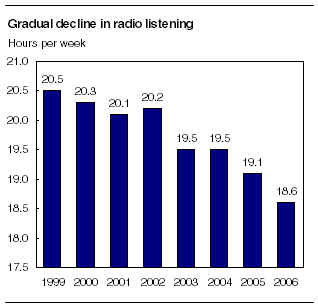Common menu bar links
Radio listening
Archived Content
Information identified as archived is provided for reference, research or recordkeeping purposes. It is not subject to the Government of Canada Web Standards and has not been altered or updated since it was archived. Please "contact us" to request a format other than those available.

Canadians devoted less time listening to their radios as a form of entertainment in 2006 than in previous years, especially teenagers and young adults, many of whom appear to be switching to digital music players and online music services.
On average, Canadians tuned in to their radios for 18.6 hours during "measurement week" in fall 2006, down from 19.1 hours a week in 2005. Since the fall of 1999, when radio listening peaked, this average has dropped by nearly two hours.
In 2006, much of the decline occurred in two age groups: teenagers aged 12 to 17 and young adults aged 18 to 24.

Teenagers listened to their radios barely 7.6 hours a week, the lowest of all age groups. This was down from 8.6 hours in 2005 and 11.3 in 1996.
Among young adult men, listening fell from 15.1 hours to 13.7. Among their female counterparts, it slipped from 15.4 hours to 14.6.
The popularity of digital music players and online music services had the biggest impact on the radio listening habits of teens and the young adult crowd.
Senior women continued to be the most ardent radio listeners, tuning in for 22.7 hours per week, virtually unchanged from 2005. Among senior men, listening edged down from 20.3 hours a week to 19.5.
Note to readersThe results in this release are based on a survey of Canadians aged 12 and older. The radio project of the Culture Statistics Program is a joint endeavour of the Canadian Radio-television and Telecommunications Commission (CRTC), the Department of Canadian Heritage, and Statistics Canada. The Statistics Canada radio listening data bank integrates files from a variety of sources. The basic listening data are acquired from BBM Canada and include demographic characteristics of survey respondents. The information on specific radio station formats is provided by the CRTC. While the return rate, at 42.5%, is modest by Statistics Canada standards, it is in line with Canadian and international broadcasting industry practices for audience measurement. However, the data should be interpreted with caution. |
The Canadian Broadcasting Corporation (CBC) was the most popular listening format for both senior men and senior women. It was least popular among young adults.
Radio listening increased in only three provinces in 2006: Newfoundland and Labrador, Nova Scotia and New Brunswick.
Residents of Nova Scotia were the most avid listeners, tuning in for 20.4 hours a week. This was 3.5 hours more each week than their counterparts in British Columbia, where listening was at a nationwide low of 16.9 hours.
The largest declines occurred in Saskatchewan, Prince Edward Island and Quebec. Listening among francophone Quebeckers slipped by a full hour a week. However, their anglophone counterparts tuned in to English-language radio for 20.8 hours a week, the highest level among the provinces.
Listeners in Nova Scotia and Prince Edward Island were a close second and third to anglophone Quebeckers.
Adult contemporary music captures over a fifth of nation's listening time
Overall, adult contemporary music was still the first choice of Canadians on the radio.
In the fall of 2006, this station format captured 22.3% of Canadians' listening time, followed by gold/oldies/rock (13.9%). The adult contemporary format was the first choice of listeners in New Brunswick, Quebec and Ontario.
The CBC rebounded to third place in overall format ranking in 2006, with an 11.6% share of the total listening audience.
The CBC's share had dropped to under 9% during the previous year, when a lockout by management coincided with the survey period.
In fourth and fifth places were talk radio and country, each capturing about one-tenth of total audience share.
The choice of station format varied considerably from province to province. Country music was the first choice for listeners in Saskatchewan, Prince Edward Island, Nova Scotia, Alberta and Manitoba.
The CBC remained a popular choice in British Columbia and Nova Scotia, capturing 17% or so of the audience for second place in both provinces.
However, the public broadcaster was least popular in Alberta, where only 8.4% of the total audience turned it on. Country music and gold/oldies/rock were by far the leading formats in Alberta.
Talk radio was a tremendously popular format in Newfoundland and Labrador, capturing a share of almost 30% of the province's radio audience. This contrasts sharply with the rest of the Atlantic provinces, where talk radio's listening share was virtually non-existent.
Available on CANSIM: tables 503-0001 to 503-0005.
Definitions, data sources and methods: survey number 3153.
Selected details from the Radio Listening Survey are now available in the publication Radio Listening: Data Tables (87F0007XIE, free) from the Publications module of our website.
For more information, or to enquire about the concepts, methods or data quality of this release, contact Client Services, Culture Statistics Program (toll-free 1-800-307-3382; 613-951-5418; fax: 613-951-1333; culture@statcan.gc.ca), Culture, Tourism and the Centre for Education Statistics.


 Table(s).
Table(s).